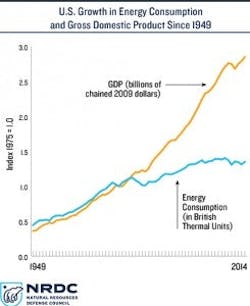New Report: Tectonic Shift in U.S. Energy Use — Renewables Surging; Coal, Oil, and Electricity Down
Electricity consumption grew at only half the rate of population growth from 2000 to 2014. And that’s only the start of the tectonic shift in U.S. energy use that the Natural Resources Defense Council uncovered in a new report. NRDC’s Ralph Cavanagh explains.
I recently heard the CEO of the nation’s largest utility tell a roomful of mostly conservative Midwest business and government leaders, gathered at the University of Missouri, that she was optimistic about prospects for cutting the nation’s carbon pollution and meeting the goals of the nation’s new Clean Power Plan to limit power plant emissions. Duke Energy’s Lynn Good could — and did– base her optimism in part on a well-documented record of U.S. achievement, which is summarized in today’s new NRDC report describing “A Tectonic Shift in America’s Energy Landscape.”
The Duke CEO is a leader in a sector that has seen dramatic improvements in energy efficiency and renewable energy performance in recent years. Consider the evidence:
What seems small is HUGE
The United States today is relying on an unprecedented amount of renewable energy from wind turbines, solar panels, and other technologies. In total, roughly 10 percent of the nation’s energy supply came from renewable sources last year.
While 10 percent may not seem like much, consider this:
That’s like powering the world’s largest economy for more than a month without using any pollution-spewing coal, oil, or natural gas; without breathing all their harmful pollutants, like the soot that contributes to respiratory illnesses and heart disease; and without the harm to our lands, waters, and wildlife that is associated with extracting fossil fuels. At the same time, smarter energy use, aka energy efficiency, is larger than ever and plays a complementary role in decarbonizing energy markets.
That’s a huge achievement, given that the great advances of the 20th century were built largely on the energy provided by fossil fuels. Fortunately, as our report shows, we are bearing witness to fundamental change in the energy sector, reflecting the needs and aspirations of all who depend on it.
But more is needed
Still, we need to do much more in order to do our share to stabilize the earth’s climate. As California’s lawmakers recognized in recent climate legislation, total emissions must drop at least 80 percent by 2050. That state did its part when Governor Jerry Brown signed into law the world’s most ambitious combined clean energy targets (SB 350) yesterday (Oct. 7). By 2030, California will double its already substantial energy efficiency savings, get at least half its electricity from renewable sources, and move millions of vehicles from gasoline to electricity.
Meanwhile, the U.S. Environmental Protection Agency’s Clean Power Plan (CPP), issued in August, will shave a third from power plant emissions over the next 15 years. Our power plants currently represent the nation’s single-largest source of the carbon pollution fueling climate change. But because the options to comply with the CPP limits will cost less than continuing to pollute, the average U.S. household will save an estimated $85 per year in electricity bills as these emissions decline.
Thanks to recent fuel economy and clean car standards, U.S. oil consumption will decline by more than 2 million barrels per day over the next decade, which is more than we buy today from any OPEC nation. Reductions in U.S. demand have also contributed to sustained downward pressure on oil prices.
A global meeting in Paris in December 2015 is rightly seen by many as a watershed in climate protection, as nations will share pledges to cut carbon pollution over the next decade. The U.S. delegation will bring something at least as important as any pledge: sustained proof that reductions in fossil fuel use and carbon pollution go hand in hand with reliable and affordable energy services.
This should prove persuasive for the Midwest leaders that Duke’s CEO addressed in the Show Me State, and almost everyone else.
Author Ralph Cavanagh is energy program co-director in San Francisco for the Natural Resources Defense Council. This blog originally appeared on Switchboard, NRDC’s staff blog.

